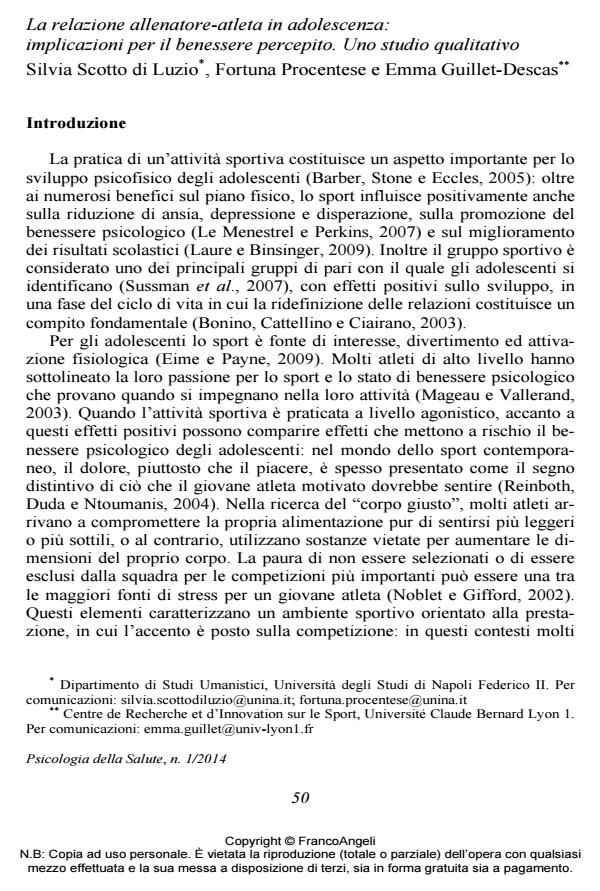The coach-athlete relationship in adolescence: implications for the perceived wellbeing. A qualitative study
Journal title PSICOLOGIA DELLA SALUTE
Author/s Silvia Scotto di Luzio, Fortuna Procentese, Emma Guillet-Descas
Publishing Year 2014 Issue 2014/1
Language Italian Pages 23 P. 50-72 File size 785 KB
DOI 10.3280/PDS2014-001003
DOI is like a bar code for intellectual property: to have more infomation
click here
Below, you can see the article first page
If you want to buy this article in PDF format, you can do it, following the instructions to buy download credits

FrancoAngeli is member of Publishers International Linking Association, Inc (PILA), a not-for-profit association which run the CrossRef service enabling links to and from online scholarly content.
The different relational contexts in which the sport activities at a competitive level are played and, in particular, the behavior and the interpersonal style of the coach, play a vital role in shaping the potential psychological effects (both positive and negative) of sports participation in adolescence. The aim of this work was to explore the process of construction and development of the coach-athlete relationship and the impact of the quality of this relationship on personal wellbeing perceived by the protagonists. To this end, 50 adolescent athletes and 21 coaches from sport clubs of the region Campania, were interviewed. The interviews, transcribed verbatim, were analyzed by Grounded Theory approach. 13 categories emerged from the analysis they are grouped into 3 main conceptual areas: 1) Roles and tasks in the coach athlete relationship. 2) The victory point of arrival or point of departure? 3) The evolution of the relationship in relation to the reference systems. The core category identified is: Benefits of the relationship: from loneliness to share. From the reading of the phenomenon, two different interactive styles that characterize the coach-athlete relationship emerge, which are strongly influenced by the symbolic meaning attributed to the concept of victory and that influence their well-being and participation. It has also identified a dimension of deep loneliness, linked to the perception of a difficulty in carving out a space and a time for reflection and dialogue about the nature of the relationship itself. This recalls the need to theorize and take action on the perception of relational contexts in terms of prevention of dropouts and promoting wellbeing.
Keywords: Coach-athlete relationship, perceived well-being, sport, adolescence, Self determination Theory
- Construction and validation of the Sport Sense of Community in Adolescence Questionnaire (SSCAQ) Silvia Scotto di Luzio, Emma Guillet‐Descas, Fortuna Procentese, Guillaume Martinent, in Journal of Community Psychology /2017 pp.783
DOI: 10.1002/jcop.21892 - Protective and risk social dimensions of emergency remote teaching during COVID‐19 pandemic: A multiple mediation study Fortuna Procentese, Flora Gatti, Emiliano Ceglie, in Journal of Community Psychology /2023 pp.67
DOI: 10.1002/jcop.22879 - People‐nearby applications and local communities: Questioning about individuals’ loneliness and social motivations toward people‐nearby applications Fortuna Procentese, Flora Gatti, in Journal of Community Psychology /2019 pp.1282
DOI: 10.1002/jcop.22175
Silvia Scotto di Luzio, Fortuna Procentese, Emma Guillet-Descas, La relazione allenatore-atleta in adolescenza: implicazioni per il benessere percepito. Uno studio qualitativo in "PSICOLOGIA DELLA SALUTE" 1/2014, pp 50-72, DOI: 10.3280/PDS2014-001003